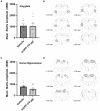Exercise reduces the anxiogenic effects of meta-chlorophenylpiperazine: The role of 5-HT2C receptors in the bed nucleus of the stria terminalis
- PMID: 36713088
- PMCID: PMC9880271
- DOI: 10.3389/fnsyn.2022.1067420
Exercise reduces the anxiogenic effects of meta-chlorophenylpiperazine: The role of 5-HT2C receptors in the bed nucleus of the stria terminalis
Abstract
Introduction: Two weeks of voluntary exercise in group-housed mice produces a reduction in anxiety-like behaviors across a number of different measures, including a reduction in the anxiety levels typically produced by the anxiogenic serotonergic drug m-chlorophenylpiperazine (mCPP), an agonist at 5-HT2C/2b receptors. We have previously demonstrated that 2-weeks of voluntary exercise blunted the anxiogenic effects of systemic mCPP, and we have also shown that mCPP infused into the bed nucleus of the stria terminalis (BNST) is anxiogenic. Here we follow up on these reports.
Methods: In Experiment 1 we infused several doses of mCPP into the BNST with or without the 5-HT2C antagonist SB242084. In Experiment 2, we administered mCPP into amygdala subregions and the dorsal hippocampus to investigate site specificity. In Experiment 4 we lesioned the BNST and subsequently infused mCPP systemically, and in Experiment 4 we used RNAscope® to assess BNST 5-HT2C transcripts following wheel running.
Results: BNST mCPP infusion increased acoustic startle responding, which was by 5-HT2C antagonism, while neither mCPP infused into the amygdala nor hippocampus was anxiogenic. Lesions of the BNST prevented the anxiogenic effect of systemically administered mCPP. Lastly, exercise reduced 5-HT2C transcripts in the BNST.
Discussion: These results suggest that the BNST is a critical site of action for the effects of exercise on mCPP. Together these data suggest that exercise may reduce 5-HT2C receptor function in the BNST, which may, in part, explain some of the anxiolytic effects associated with wheel running.
Keywords: anxiety; extended amygdala; serotonin; stress; wheel running.
Copyright © 2023 Fox, Boucher, Abedrabbo, Hare, Grimmig, Falls and Hammack.
Conflict of interest statement
The authors declare that the research was conducted in the absence of any commercial or financial relationships that could be construed as a potential conflict of interest.
Figures




Similar articles
-
Exercise is associated with reduction in the anxiogenic effect of mCPP on acoustic startle.Behav Neurosci. 2008 Aug;122(4):943-8. doi: 10.1037/0735-7044.122.4.943. Behav Neurosci. 2008. PMID: 18729648
-
Anxiogenic and aversive effects of corticotropin-releasing factor (CRF) in the bed nucleus of the stria terminalis in the rat: role of CRF receptor subtypes.Psychopharmacology (Berl). 2006 May;186(1):122-32. doi: 10.1007/s00213-006-0362-y. Epub 2006 Mar 28. Psychopharmacology (Berl). 2006. PMID: 16568282 Free PMC article.
-
Dorsal BNST α2A-Adrenergic Receptors Produce HCN-Dependent Excitatory Actions That Initiate Anxiogenic Behaviors.J Neurosci. 2018 Oct 17;38(42):8922-8942. doi: 10.1523/JNEUROSCI.0963-18.2018. Epub 2018 Aug 27. J Neurosci. 2018. PMID: 30150361 Free PMC article.
-
Agomelatine for the treatment of generalized anxiety disorder: focus on its distinctive mechanism of action.Ther Adv Psychopharmacol. 2022 Jun 30;12:20451253221105128. doi: 10.1177/20451253221105128. eCollection 2022. Ther Adv Psychopharmacol. 2022. PMID: 35795687 Free PMC article. Review.
-
Chemoarchitecture of the bed nucleus of the stria terminalis: Neurophenotypic diversity and function.Handb Clin Neurol. 2021;179:385-402. doi: 10.1016/B978-0-12-819975-6.00025-X. Handb Clin Neurol. 2021. PMID: 34225977 Free PMC article. Review.
Cited by
-
Neurotransmitter Alterations in Prediabetes and Type 2 Diabetes Mellitus: A Narrative Review.Int J Mol Sci. 2025 Aug 14;26(16):7847. doi: 10.3390/ijms26167847. Int J Mol Sci. 2025. PMID: 40869170 Free PMC article. Review.
-
Effects of an exercise intervention on maternal depression, anxiety, and fatigue: a systematic review and meta-analysis.Front Psychol. 2024 Nov 18;15:1473710. doi: 10.3389/fpsyg.2024.1473710. eCollection 2024. Front Psychol. 2024. PMID: 39624371 Free PMC article.
-
Multiple Sex- and Circuit-Specific Mechanisms Underlie Exercise-Induced Stress Resistance.Curr Top Behav Neurosci. 2024;67:37-60. doi: 10.1007/7854_2024_490. Curr Top Behav Neurosci. 2024. PMID: 39080242 Review.
-
Effects of exercise on psychological distress in patients with COPD: A systematic review and meta-analysis of randomised controlled trials.Medicine (Baltimore). 2025 Aug 22;104(34):e44026. doi: 10.1097/MD.0000000000044026. Medicine (Baltimore). 2025. PMID: 40859513 Free PMC article.
-
Female rats are more responsive than are males to the protective effects of voluntary physical activity against the behavioral consequences of inescapable stress.Stress. 2023 Nov;26(1):2245492. doi: 10.1080/10253890.2023.2245492. Stress. 2023. PMID: 37549016 Free PMC article.
References
-
- Bagdy G., Graf M., Anheuer Z. E., Modos E. A., Kantor S. (2001). Anxiety-like effects induced by acute fluoxetine, sertraline or m-CPP treatment are reversed by pretreatment with the 5-HT2C receptor antagonist SB-242084 but not the 5-HT1A receptor antagonist WAY-100635. Int. J. Neuropsychopharmacol. 4, 399–408. 10.1017/S1461145701002632 - DOI - PubMed
-
- Bristow L. J., O'Connor D., Watts R., Duxon M. S., Hutson P. H. (2000). Evidence for accelerated desensitisation of 5-HT(2C) receptors following combined treatment with fluoxetine and the 5-HT(1A) receptor antagonist, WAY 100,635, in the rat. Neuropharmacology 39, 1222–1236. 10.1016/S0028-3908(99)00191-4 - DOI - PubMed
Grants and funding
LinkOut - more resources
Full Text Sources

